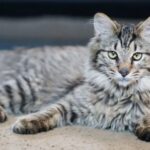A happy “teddy bear” of a cat, this breed is loving and patient and enjoys being in the company of its human companions.
This cat takes its name from the Selkirk Mountains near its place of origin in Montana. Created in the late 1980s, the breed had its beginnings in an animal shelter, where a curly-coated kitten appeared among an otherwise straightcoated litter born to a feral cat.
This kitten became the founding female of the Selkirk Rex. As the breed was developed, planned matings with pedigree cats produced both the Selkirk Rex shorthair and a longercoated type that was the result of crosses with Persians. Straight-coated variants are common in litters of both types.
The dense, soft coat of the Selkirk Rex falls into random curls or waves, rather than in the neat lines sometimes seen in other Rex breeds. A greater degree of curl often occurs around the neck and belly. The whiskers are sparse and curly and tend to snap off easily.
Grooming a Selkirk Rex is not difficult but a light touch is advisable, since overly vigorous brushing can flatten out the curls. Though calm and tolerant, this cat is far from staid and loves a hug. Selkirks stay kittenish for years and always enjoy games.
Becoming Curly
The curls of a Selkirk Rex can take two years to develop fully. It is immediately obvious which of a litter of kittens will be curly, since their whiskers are curly from birth. In kittens born with a rexed coat, the fur—but not the whiskers—usually straightens for a few months before beginning to curl again when the cat is about eight months old.
The best coats appear in spayed females and in adult males, whether they are neutered or not.
Origin: US, 1980s
Breed registries: CFA, TICA
Weight range: 7–11lb (3–5kg)
Grooming: 2–3 times a week
Colors and patterns: All colors, shades, and patterns.











